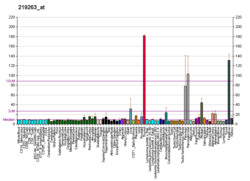RNF128
E3 ubiquitin-protein ligase RNF128 is an enzyme that in humans is encoded by the RNF128 gene.[5]
The protein encoded by this gene is a type I transmembrane protein that localizes to the endocytic pathway. This protein contains a RING zinc-finger motif and has been shown to possess E3 ubiquitin ligase activity. Expression of this gene in retrovirally transduced T cell hybridoma significantly inhibits activation-induced IL2 and IL4 cytokine production. Induced expression of this gene was observed in anergic CD4(+) T cells, which suggested a role in the induction of anergic phenotype. Alternatively spliced transcript variants encoding distinct isoforms have been reported.[5]
Interactions
RNF128 has been shown to interact with CD154[6] and OTUB1.[7]
References
- 1 2 3 GRCh38: Ensembl release 89: ENSG00000133135 - Ensembl, May 2017
- 1 2 3 GRCm38: Ensembl release 89: ENSMUSG00000031438 - Ensembl, May 2017
- ↑ "Human PubMed Reference:".
- ↑ "Mouse PubMed Reference:".
- 1 2 "Entrez Gene: RNF128 ring finger protein 128".
- ↑ Lineberry, Neil B; Su Leon L; Lin Jack T; Coffey Greg P; Seroogy Christine M; Fathman C Garrison (Aug 2008). "Cutting edge: The transmembrane E3 ligase GRAIL ubiquitinates the costimulatory molecule CD40 ligand during the induction of T cell anergy". J. Immunol. United States. 181 (3): 1622–6. doi:10.4049/jimmunol.181.3.1622. PMC 2853377. PMID 18641297.
- ↑ Soares, Luis; Seroogy Christine; Skrenta Heidi; Anandasabapathy Niroshana; Lovelace Patricia; Chung Chan D; Engleman Edgar; Fathman C Garrison (Jan 2004). "Two isoforms of otubain 1 regulate T cell anergy via GRAIL". Nat. Immunol. United States. 5 (1): 45–54. doi:10.1038/ni1017. ISSN 1529-2908. PMID 14661020.
Further reading
- Kostianovsky AM, Maier LM, Baecher-Allan C, et al. (2007). "Up-regulation of gene related to anergy in lymphocytes is associated with Notch-mediated human T cell suppression". J. Immunol. 178 (10): 6158–63. doi:10.4049/jimmunol.178.10.6158. PMID 17475842.
- MacKenzie DA, Schartner J, Lin J, et al. (2007). "GRAIL is up-regulated in CD4+ CD25+ T regulatory cells and is sufficient for conversion of T cells to a regulatory phenotype". J. Biol. Chem. 282 (13): 9696–702. doi:10.1074/jbc.M604192200. PMID 17259178.
- Ross MT, Grafham DV, Coffey AJ, et al. (2005). "The DNA sequence of the human X chromosome". Nature. 434 (7031): 325–37. Bibcode:2005Natur.434..325R. doi:10.1038/nature03440. PMC 2665286. PMID 15772651.
- Gerhard DS, Wagner L, Feingold EA, et al. (2004). "The status, quality, and expansion of the NIH full-length cDNA project: the Mammalian Gene Collection (MGC)". Genome Res. 14 (10B): 2121–7. doi:10.1101/gr.2596504. PMC 528928. PMID 15489334.
- Ota T, Suzuki Y, Nishikawa T, et al. (2004). "Complete sequencing and characterization of 21,243 full-length human cDNAs". Nat. Genet. 36 (1): 40–5. doi:10.1038/ng1285. PMID 14702039.
- Soares L, Seroogy C, Skrenta H, et al. (2004). "Two isoforms of otubain 1 regulate T cell anergy via GRAIL". Nat. Immunol. 5 (1): 45–54. doi:10.1038/ni1017. PMID 14661020.
- Anandasabapathy N, Ford GS, Bloom D, et al. (2003). "GRAIL: an E3 ubiquitin ligase that inhibits cytokine gene transcription is expressed in anergic CD4+ T cells". Immunity. 18 (4): 535–47. doi:10.1016/S1074-7613(03)00084-0. PMID 12705856.
- Strausberg RL, Feingold EA, Grouse LH, et al. (2003). "Generation and initial analysis of more than 15,000 full-length human and mouse cDNA sequences". Proc. Natl. Acad. Sci. U.S.A. 99 (26): 16899–903. Bibcode:2002PNAS...9916899M. doi:10.1073/pnas.242603899. PMC 139241. PMID 12477932.
This article is issued from
Wikipedia.
The text is licensed under Creative Commons - Attribution - Sharealike.
Additional terms may apply for the media files.




